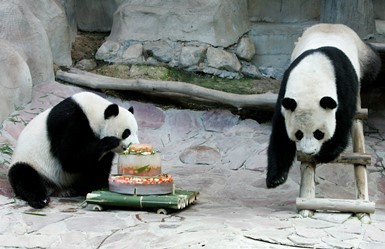Frozen panda semen from China was transported for the first time to be used in this year’s breeding season by the National Zoo in Washington.
The China Daily reported that the imported semen will be used for the artificial insemination of Mei Xiang, a 16-year-old female giant panda in the National Zoo.
"This is the first time we've imported semen from China for panda breeding," Dennis Kelly, director of the zoo, was quoted as saying.
The frozen semen was brought to Washington by Caitlin Burrell, a research scientist at the Smithsonian Conservation Biology Institute (SCBI), who arrived at Dulles International Airport on April 20.
The report said tat the sperm sample was taken from Hui Hui, a 9-year-old male giant panda at the China Research and Conservation Center for the Giant Panda located in Wolong, Sichuan Province. Scientists later froze and stored the sample at the Bifengxia Giant Panda Base's cryopreservation bank.
The sample is now preserved in the SCBI's cryopreservation bank at the National Zoo, the report added.
Through a cooperative research and breeding agreement between China Wildlife Conservation Association and the Washington zoo, Mei Xiang was brought to the National Zoo in Jan. 2011.
Mei Xiang has produced two cubs--Tai Shan and Bao Bao--with a male giant panda, Tian Tian.
The National zoo said that a cub sired by Hui Hui would be more valuable to the gene pool because Hui Hui has not sired any cubs yet.
The zoo's panda team said that Mei Xiang is expected to go into a period of excitability and fertility called estrus for 24 to 72 hours in the next week or two, before the artificial insemination procedure takes place.
According to the report, scientists from the National Zoo have traveled around the world to find the match for this year's panda breeding season. SCBI scientist Jon Ballou made the breeding recommendations based on analysis of the best genetic matches.
Scientists from both China and the U.S. work to increase the number of giant pandas living under human care from 392 to 500, as experts from the countries have worked together to study how giant pandas reproduce, including their diseases before they release them back into the wild later.
Tai Shan, the first cub of Mei Xiang and Tian Tian and born in Washington, now lives in China. As common practice, Bao Bao, their second cub, will be brought to China when she reaches four years old.
"Chinese experts are much more experienced than we are, and we tend to learn from each other every day," Kelly told China Daily.
The zoo director said that the U.S. zoo has worked on many scientific projects with China for decades, and would continue to collaborate with Chinese scientists on giant panda breeding.



























